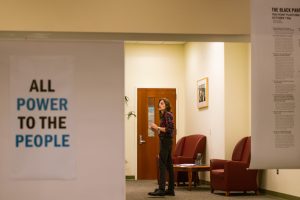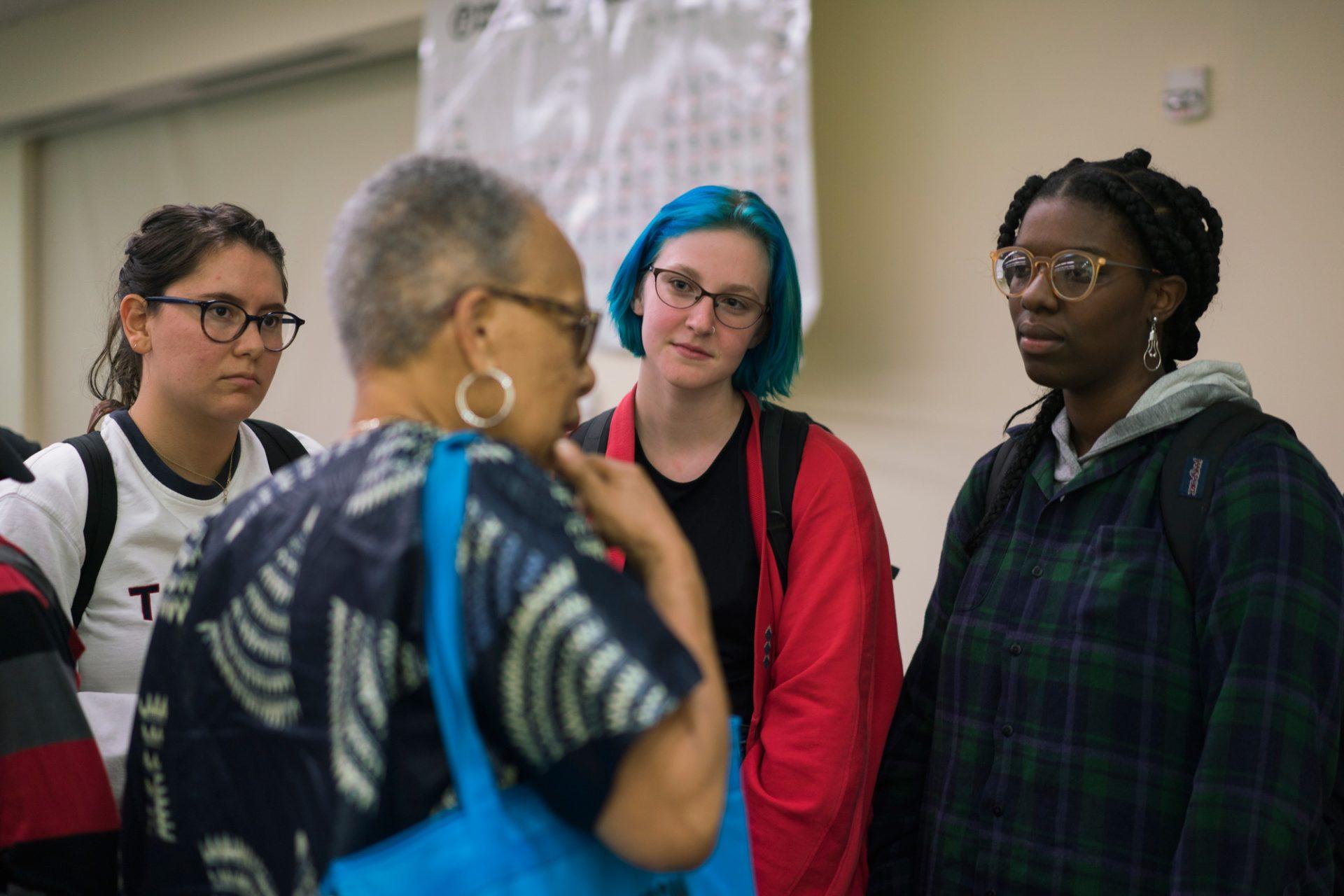The Center for Judaic, Holocaust and Peace Studies hosted a panel discussion on Oct. 17 with three former members of the Black Panther Party.
The panel was a supplement to the traveling exhibit constructed by Suzun Lucia Lamaina, photographer and college professor. Lamaina spent five years documenting the lives of former Black Panther Party members across the country, including the panel discussion members.
The photographic essay, “Revolutionary Grain: Celebrating the Spirit of the Black Panther Party in Portraits and Stories,” is on display on the first and fourth floors of Belk Library from Oct. 15 to Dec. 15.
Barbara Easley Cox, of the International Section; Billy X Jennings, of the Central Headquarters in Oakland, California; and John R. Hayes, known as “Ras John,” of the Winston-Salem chapter were part of the discussion.
They discussed the history of the Black Panther Party, the Black Freedom Struggle of the 1960s, domestic and international activism, and its community programs, such as free breakfast and medical clinics.
A packed room welcomed the former members for their panel discussion. Cox said she always counts the number of black people and people of color in the room at any event she does.
“I was (a) little disappointed in the numbers,” Cox said.
She said she was, however, impressed by the number of white students in attendance, who were paying attention and asking questions after the panel discussion.
Jennings said he expected to provide App State students with rare insight and an outlet to learn from former members.
“They might have heard some negative stuff, so this is a chance for them to ask questions and find out the truth,” Jennings said.
Hayes said he wanted help students understand more about the Black Panther Party. He said he wanted students to know that members of the party are alive and willing to answer questions.
“We’re still alive here today to tell the story and it’s no small matter that we’re still alive,” Hayes said.
Jennings believes that advances in technology have caused the relationships among black people, people of color and the police to get worse since the 1960s.
“The police have not relinquished any of their power whatsoever; they still can get away with anything,” Jennings said. “But the thing about now, there are people in different parts of the community who are standing up because there is now the same police brutality in their community.”
The legacy of the Black Panther Party thrives in pop culture, according to the former members. They said since the release of the motion picture “Black Panther” in February more young black people wear traditional African garments such as Dashikis and clothing with Black Panther Party symbols on them.
“Culture is a weapon,” Cox said.
Jennings said he was impressed by the books and films that are telling the story of the Black Panther Party.
“The recognition is finally coming. The burden we’ve been bearing for 50 years is bearing fruit in this particular generation,” Jennings said.
The members said they don’t think the methods and ideologies of the Black Panther Party that were formed in 1966 would be received well in 2018.
“You can’t put a square peg in a round hole because times are different,” Jennings said. “The stuff that you wore 10 years ago, I know you wouldn’t be wearing it again. The consciousness of our people has risen to a higher level.”
Jennings also said that the New Black Panther Party is not associated with the Black Panther Party of the 1960s.
“The party from yesteryear, gun toting and stuff, wouldn’t fit into the situation,” Jennings said. “That’s why the New Panthers ain’t never going to be about nothing. They don’t have an ideology, they don’t have a philosophy, they’re trying to go on what we did 50 years ago.”
The Black Freedom Struggle of the 1960s has not changed in this modern era, only the wording has changed, according to the members.
Huey P. Newton and Bobby Seale founded the Black Panther Party in October 1966. They wrote a set of guidelines for the party called the Ten-Point Program. Jennings said the demands of the program are still relevant.
“First thing: ‘We want freedom. We want power to determine the destiny of our black community. So today, we’d say we want empowerment. Just change the words, but it means the same thing,” Jennings said.

Along with the 48 national chapters of the Black Panther Party, thee International Section was represented. Cox said the section had a huge responsibility for the four Black Panthers representing the party and African-Americans in Africa.
“We were given a (of) lot prestige and favoritism, but in America, the chapters were going through shoot ‘em outs, lockups, beatdowns, mysterious deaths, and we didn’t have that over there,” Cox said.“I didn’t realize it at the time but in hindsight, going back now, African-Americans were a novelty.”
Jennings said the International Section of the Black Panther Party helped connect struggles and revolutions happening across the world.
“The impact of the Black Panther Party was so international,” Jennings said. “Out of our embassy there became Polynesian Panthers, they became Aboriginal Panthers. There was a group called the Israeli Panthers. There were different groups around the world that related to the Black Panther Party.”
The Winston-Salem chapter of the Black Panther Party was the first and the strongest in the South. Former member Hayes said it is because it was always on the frontlines and took the causes no one else wanted to touch.
Hayes said the Winston-Salem chapter is known for preventing police from evicting a white woman from her home in its community.
“They went to her house and set everything out in the doggone snow, so we went down to the house and put everything back in the house,” Hayes said. “And when the sheriff came, we were standing up with guns like ‘No, you’re not messing with this woman, get away from here.’”
Winston-Salem’s chapter was also the only one to have an ambulance service that would pick up black people in the community.
Jennings said Black Panthers across the country were proud to see pictures of the Winston-Salem chapter’s ambulance service in the Black Panther newspaper.
“There was no such thing as ‘can’t,’” Hayes said.
In September 1968, FBI director J. Edgar Hoover said the Black Panthers were “the greatest threat to the internal security” of the U.S.
“It’s a misleading statement. What about the mafia? They’re in every state,” Jennings said. “The Black Panther Party only had 48 chapters. It was a racist move to justify what they (are) getting to do to us.”
The Black Panther Party began its Free Breakfast for Children community service program in January 1969. By the end of the year, the party was feeding over 10,000 students.
“I remember when that statement was made by Hoover and I was like, ‘What does that really mean?’” Cox said. “But it was the breakfast program that really was a threat because you had young children learning our songs, marching, so that was one of the things that they came after us about.”
The members want young activists to know the struggle is not over and that they can still learn from the Black Panther Party.
“As long as we’re still looking (at) things in terms of black and white there will always be a struggle,” Hayes said.
“You have to study, know what you’re talking about, know the history of the problem and what you’re trying to project. When you go out to the community, be prepared to deal with the people,” Jennings said.
Story by Cadesha Clarke, A&E Reporter
Photo by Hayley Canal, Staff Photographer
Featured Photo Caption: Barbara Easley Cox offers advice to students after the panel discussion. During the Q&A, Cox encouraged students to seize their opportunity to speak to “living history.”


